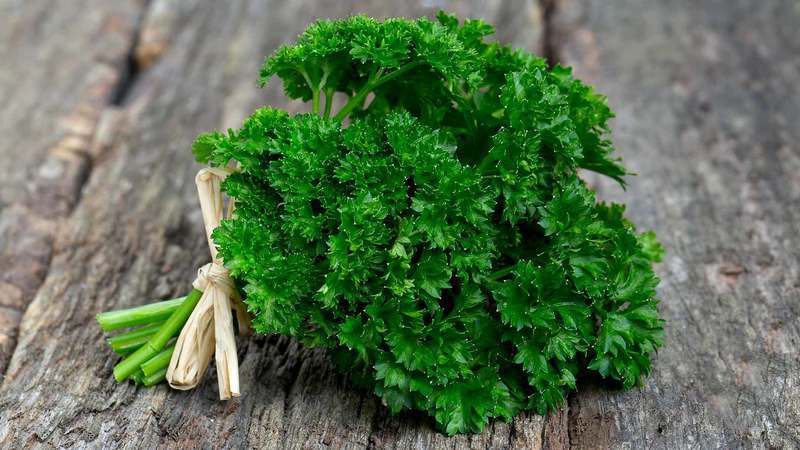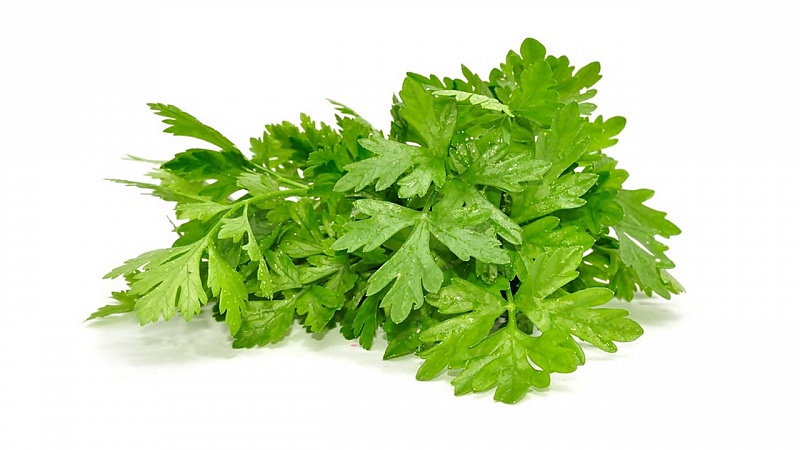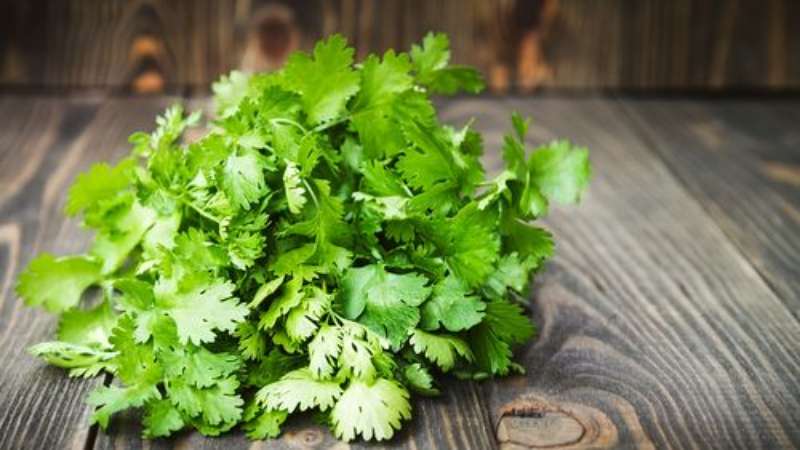Medicinal properties of parsley and contraindications for use
Parsley grows even on rocky soils, which is very convenient for her cultivation... In cooking, there are 2 main types of plants - curly and Italian. In the first, the leaves are wrinkled with a bitter aftertaste, in the second, they are flat with a pronounced aroma.
We will talk about the chemical composition of parsley, its benefits and medicinal properties, health hazards and contraindications in this article.
The content of the article
Parsley composition

If the greens were grown without the addition of unnecessary chemical fertilizers and growth accelerators, they will be very useful.
100 g of the product contains the following vitamins:
- K - 658% of the daily value;
- C - 431%;
- beta-carotene - 111%;
- B1 - 7%;
- B2 - 17%;
- B6 - 10%;
- B9 - 29%;
- E - 18%.
The leaves and stems of parsley are rich in macronutrients such as:
- silicon - 50%;
- potassium - 24%;
- calcium - 20%;
- magnesium - 16%;
- phosphorus - 10%;
- sodium - 9%;
- chlorine - 7%.
The main trace elements in greens:
- manganese - 155%;
- boron - 107%;
- vanadium - 61%;
- iron - 48%;
- nickel - 43%;
- rubidium - 42%;
- cobalt - 41%;
- lithium - 21%;
- iodine - 17%;
- chromium - 16%;
- copper - 12%;
- zinc - 11%.
At the roots, the composition is not so rich, but also healthy. They contain:
- vitamins K, C, group B;
- potassium, silicon, phosphorus, calcium, magnesium;
- boron, vanadium, manganese, copper, rubidium, zinc, cobalt.
Calorie content and BZHU
The calorie content of the aerial part of parsley is low -: there are 36 kcal per 100 g. At the roots, the value is higher - 51 kcal.
The nutritional value of the plant per 100 g is presented in the table:
| Substances | Greenery | Root |
| Protein | 3.2-4.5 g - 5% | 1.5 g - 3% |
| Fats | 1.2 g - 1% | 0.6 g - 1% |
| Carbohydrates | 4.6-10.2 g - 2% | 13.3 g - 5% |
The glycemic index of the green part of parsley is 5 units, of the roots - 10. This is a low indicator, for example, in comparison with dill (15), radish (15), cucumber (20). Greens are good for people with diabetes.
The polysaccharide inulin, found in parsley, normalizes blood glucose levels.
Is it suitable for losing weight
Parsley is a low-calorie plant, so it is well suited for those who monitor their weight or want to reduce it. The plant has a diuretic effect: decoctions of leaves, stems, seeds and roots flush out excess water from the body. This contributes to the removal edema and weight management.
Important! It is impossible to abuse decoctions from a diuretic plant, since valuable substances are excreted along with urine. The product is used systematically, otherwise excess liquid will accumulate again.
Dietary fiber suppresses appetite, which reduces the daily calorie intake. The body is cleansed of cholesterol and harmful substances. Fat metabolism is stimulated in the structure of the subcutaneous tissue, which helps to get rid of cellulite. Parsley infusions soothe the nervous system, so even the strictest diet does not violate the psycho-emotional state.
Infusions, decoctions, teas are made from the plant. Leaves and stems are added to salads, soups. Parsley is eaten dry, fresh or frozen.
Useful properties of parsley
The level of vitamin C in greens is higher than in lemon and other citrus fruits. The plant strengthens the immune system and has an antioxidant effect.

Some of the beneficial effects of parsley:
- lowering blood sugar levels;
- beneficial effects on the digestive system;
- help in removing kidney stones;
- prevention of cardiovascular diseases;
- antiseptic properties;
- normalization of hormonal levels;
- elimination of bad breath, wound healing and elimination of inflammation;
- toning and cleansing the skin;
- reducing swelling and pain from insect bites.
Parsley is useful for people whose lifestyle or profession is closely associated with high mental, physical stress and systematic lack of sleep. This plant has beneficial effects on oxygen balance and stabilizes brain function.
For women
Women parsley is useful because it relieves muscle spasms and painful symptoms during the menstrual cycle. Thanks to folic acid, reproductive function is normalized and the correct formation of the fetus is ensured during pregnancy.
Important! The plant is added to the diet of a pregnant woman in moderation, as it speeds up blood circulation in the pelvic area and increases the risk of premature birth or fetal rejection.
For the prevention, treatment or elimination of symptoms of cystitis, decoctions of parsley leaves and stems are used. It is important to remember that the plant is not a substitute for drugs and is used as an adjunct to the main therapy.
For men
Parsley has a positive effect on the male reproductive system. The bioflavonoid apigenin contained in the plant reduces the amount of female hormones, increases the synthesis of testosterone, has powerful antioxidant properties, and is effective in the fight against prostate cancer and diseases.
Daily use of the plant reduces the risk of manifestations of diseases of the vascular and cardiac system. Parsley removes not only toxins, but also ethyl alcohol, which is especially important after rich feasts.
For kids
The biochemical composition of parsley retains its benefits even after a short heat treatment. So, thanks to essential oils, resistance to viral diseases increases. The high content of vitamins A and E promotes accelerated healing of damaged tissues.
Iron, chlorophyll, folic acid improve the condition of the blood, which has a positive effect on the child's body in case of anemia. Potassium and magnesium lower blood pressure, normalize heart function, and maintain muscle tone.
In adolescence, this plant cleanses the skin - helps get rid of acne, blackheads, freckles. It is used as a mask or simply added to the diet.

What parts of the plant are used
Depending on the recipe, take the root, stems, leaves or seeds. They are soaked or boiled.
Fresh plant brings the greatest benefit to the human body. However, in winter it is difficult to grow it in sufficient quantities indoors, so the greens are stored until the next season in any of the following ways: canning, salting, drying, freezing (both chopped and in ice cubes).
Application features and recipes
All parts of parsley are used in medicine and cosmetology, as well as in cooking, and even in everyday life. For this, any varieties are used, but the most popular are Beads, Titan, Rialto.
Slimming
The plant is used for weight loss in a complex, in combination with proper nutrition, adherence to a healthy lifestyle and physical activity. There are many recipes for parsley.
To choose the right one, they are guided by their preferences:
- To prepare the broth, 50 g of chopped greens are poured into 1 liter of hot water, brought to a boil and cooked for 5 minutes. The product is cooled and filtered. Consume 200 ml 15 minutes before meals.
- To make an infusion, 1/2 tsp. seeds are poured into a glass and poured with boiling water to the brim. Keep under the lid for 10 minutes. They drink 180 ml twice a day at any time.
Use chopped fresh or frozen herbs to season your mashed potatoes.
In cosmetology

Parsley contains elements important for the skin:
- carotene protects the skin from the sun's rays, helps to keep it elastic and smooth, maintains water balance;
- vitamin PP saturates the skin with oxygen and improves blood circulation;
- vitamin B2 is involved in the renewal of epidermal cells.
To make a nourishing mask, mix 30 g of chopped greens and 100 g of sour cream and apply on the face for 15–20 minutes. Then they are washed off with cool water without soap or cosmetics.
In folk medicine
The root of the plant is used in folk medicine to prevent cardiovascular diseases. To prepare a decoction of 40 g of finely chopped root, pour 1/4 tbsp. boiling water, insist under the lid for 12 hours, filter and add 10 g of lime honey. Is taken internally 15 g 4 times a day half an hour before meals.
At home
Sometimes parsley is used outside the box, for example, eggs are painted greenish with juice for Easter.
In the garden, the plant helps to get rid of aphids, as it releases enzymes that repel insects. Together with other components it is used as fertilizer.
Possible harm and contraindications
The main contraindications are allergy to the product, the acute stage of diseases of the genitourinary and digestive systems.
When consumed excessively, greens can lead to headaches, nausea, seizures, and a sharp weight loss. The daily norm for a person is no more than 100 g of a plant.
Conclusion
Eating parsley within the normal range will relieve the symptoms of diseases of the genitourinary system, strengthen the heart and blood vessels, normalize the psycho-emotional state, and improve the appearance. Both adults and children are useful not only for the leaves and stems of the plant, but also for the roots and seeds.